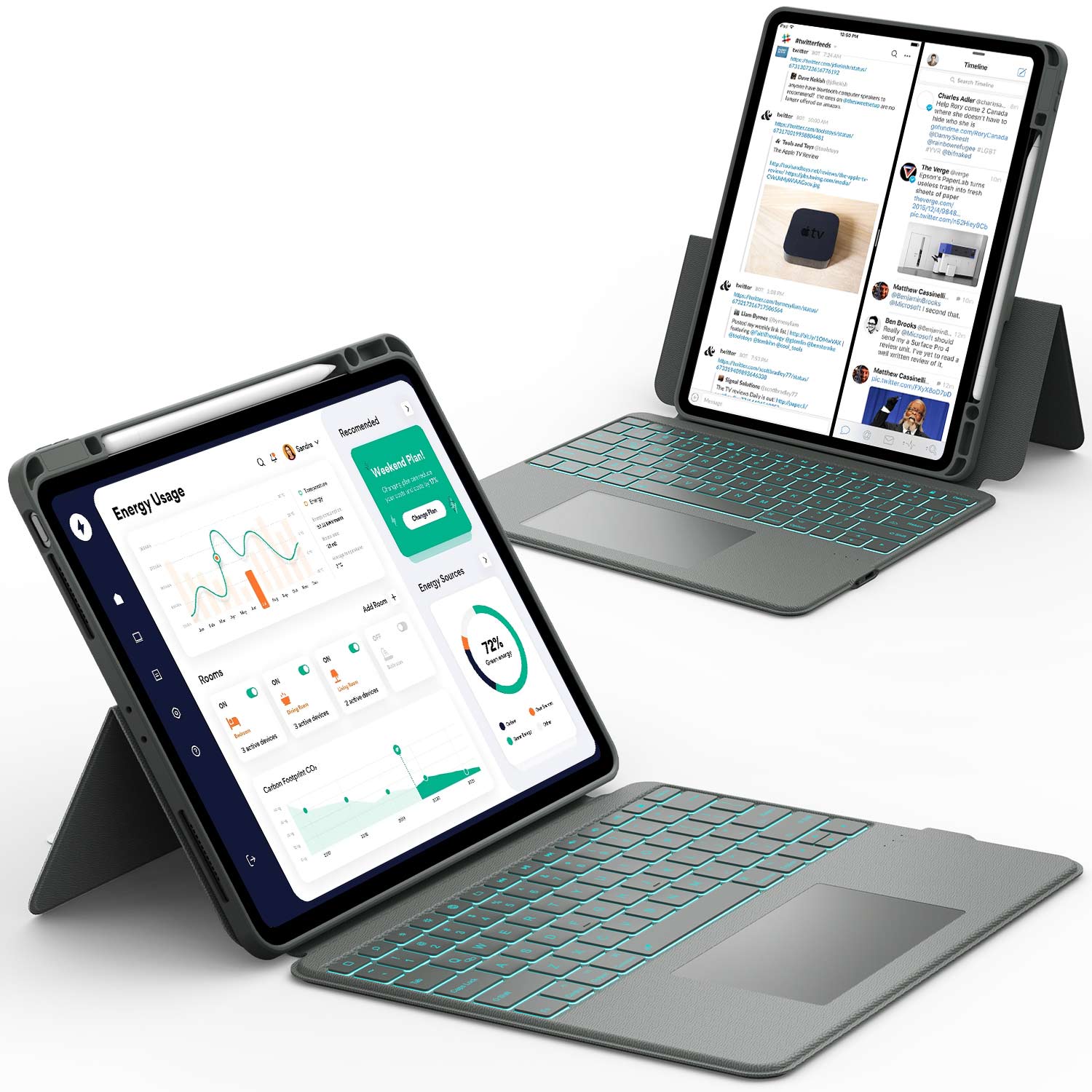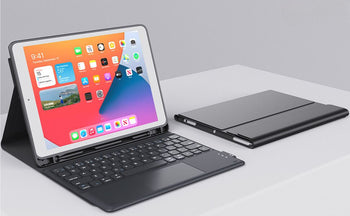It feels like every kid these days is glued to a screen, right? iPads, phones, tablets – they're everywhere. And while these gadgets can be great for learning or just chilling out, it's easy for kids to get a little too wrapped up in them. If you're starting to wonder how to pull your child away from their iPad without a major meltdown, you're in the right place. We're going to talk about how to spot if it's becoming a problem and some simple ways to get things back on track.
Key Takeaways
- Watch for signs like your child getting upset when the iPad is taken away, or losing interest in other fun things they used to do.
- Set clear rules about when and where the iPad can be used. It helps everyone know what to expect.
- Your own screen habits matter! Kids learn by watching you, so try to put your devices down sometimes.
- Don't just take the iPad away; offer other fun things to do instead, like playing outside or doing crafts.
- Use parental control settings to help manage screen time and what your child can access.
Recognizing The Signs Of iPad Overuse

It's easy to let kids use iPads a lot. They're great for keeping them busy, but it's important to know when it's too much. Spotting the signs of overuse early can help you make changes before it becomes a bigger problem. It's not about being a perfect parent, but about being aware and responsive.
Emotional And Physical Withdrawal
One of the first things to watch for is withdrawal. It's not just for serious addictions; kids can show withdrawal symptoms when their iPad time is cut short. This can look like increased irritability, anxiety, or even sadness. If your child has big mood swings when the iPad is taken away, it might be a sign they're too dependent on it. It's like they're missing something important, and it throws them off balance.
Distance From Previously Loved Activities
Has your child stopped enjoying things they used to love? Maybe they don't want to play outside as much, or they're skipping their favorite hobbies. If they're choosing the iPad over everything else, it's a red flag. It's normal for interests to change, but a sudden and complete shift towards screen time is worth paying attention to. It could mean they're relying on the iPad for entertainment and losing interest in other activities that are important for their development.
Increased Time And Boundary Pushing
At first, it might have been just a quick game or video. But now, it's hours on end, and they're always asking for more time. They might start pushing boundaries, trying to sneak in extra screen time when you're not looking. This is a classic sign of overuse. It's like their tolerance is building up, and they need more and more iPad time to feel satisfied. It's important to be firm and consistent with your rules, or it can quickly spiral out of control.
It's not about demonizing the iPad. It's about finding a healthy balance. If you see these signs, it's time to take action and help your child develop a more balanced relationship with technology.
Setting Clear Boundaries And Expectations
It's easy for iPad use to spiral out of control if there aren't any rules in place. Establishing clear boundaries and expectations is super important for managing your child's screen time and preventing potential addiction. It's not just about saying 'no'; it's about creating a structured environment where they understand the limits and the reasons behind them. This helps them develop self-discipline and a healthy relationship with technology.
Creating A Family Media Policy
Think of a family media policy as your family's rulebook for all things digital. It's a document, either written down or just clearly communicated, that outlines how and when devices can be used. This isn't just for the kids; it's for everyone in the family, including you! A good policy should cover:
- Screen-free zones: Where are devices not allowed? Maybe the dinner table or bedrooms?
- Time limits: How much screen time is allowed each day? This will vary depending on your child's age and needs. There are even apps to monitor screen time that can help with this.
- Content rules: What types of apps, games, and websites are allowed? This is especially important for younger kids.
Implementing Gradual Screen Time Reduction
Going cold turkey can be tough, especially for kids who are really into their iPads. Instead of just cutting them off completely, think about easing them into a less screen-filled life. It's all about baby steps. Here's how:
- Start small: Reduce screen time by 15-30 minutes each day or every few days.
- Communicate: Talk to your child about why you're making these changes. Explain that it's about balance and not punishment.
- Set expectations: Be clear about the new limits and when they'll be adjusted again.
Being Firm When Necessary
Sometimes, you just have to be the boss. I know, I know, it sounds harsh, but hear me out. We're not talking about being a dictator, but rather setting clear, firm boundaries. It's about taking control of the situation and making the tough calls for your child's well-being. It's not always fun, but it's necessary.
Think of it as being the captain of a ship. You're responsible for steering it in the right direction, even when the seas get rough. Your kids might not always like your decisions, but they'll appreciate the stability and guidance in the long run.
Here's how to be the boss without turning into a tyrant:
- Set Time Limits: Enforce the screen time limits you've established. No ifs, ands, or buts.
- No Screens Before Bed: This is a non-negotiable rule. The blue light messes with sleep, and a tired kid is a cranky kid.
- Device-Free Zones: Designate certain areas, like the dinner table, as device-free zones. Family time should be family time.
Leading By Example With Your Own Device Use

It's easy to focus on our kids' screen time, but let's be honest: how much time do we spend on our devices? Kids are always watching, and they pick up on our habits more than we realize. If they see us constantly glued to our phones, they'll think it's normal, even necessary. You can't expect them to disconnect if you're always plugged in.
Assessing Your Own Screen Habits
Take a good, hard look at your own device use. Are you checking emails at the dinner table? Scrolling through social media while your kids are trying to talk to you? It's easy to fall into these habits without even realizing it. Try tracking your screen time for a few days. You might be surprised by the digital detox numbers. Understanding your own habits is the first step to making a change.
Modeling Healthy Device Behavior
Once you're aware of your own screen habits, you can start modeling better behavior. This doesn't mean you have to give up your devices entirely, but it does mean being more mindful of when and how you use them.
Here are a few ideas:
- Set specific times for checking emails and social media.
- Designate tech-free zones in your home, like the dinner table or bedrooms.
- Find hobbies or activities that you enjoy that don't involve screens.
Prioritizing Real-World Interactions
It's important to show your kids that there's more to life than what's on a screen. Make a conscious effort to prioritize real-world interactions. Plan family activities that don't involve devices, like going for a hike, playing a board game, or just having a conversation.
It's not about being perfect, but about making a conscious effort to create a healthier balance. Remember, you're the role model. If you want your kids to cut back on their screen time, you need to show them that you can do it too.
Replacing Screen Time With Engaging Activities

It's not enough to just take away the iPad. Kids need something to fill that void, something that's actually appealing. The iPad is easy, instantly gratifying, and requires minimal effort. The replacement has to at least try to compete. Finding the right replacement activities might take some trial and error.
Encouraging Outdoor Play And Exploration
Get those kids outside! Fresh air and sunshine can do wonders. Instead of another hour glued to a screen, suggest a bike ride, a trip to the park, or even just some time playing in the backyard. Nature offers endless opportunities for exploration and discovery. Consider a nature scavenger hunt, where kids search for specific items like leaves, rocks, and insects. This combines outdoor activity with a sense of purpose and adventure. You can even make it educational by identifying different plants and animals. For more ideas, this article offers healthy alternatives to screen time.
Promoting Creative Hobbies And Crafts
Unleash your child's inner artist! Arts and crafts are a fantastic way to stimulate creativity and provide a tangible alternative to screen-based entertainment. Here are some ideas:
- Painting and drawing: Provide a variety of art supplies, such as watercolors, crayons, and colored pencils. Encourage your child to express themselves freely.
- Sculpting with clay or playdough: This is a great sensory activity that can help develop fine motor skills.
- Building with LEGOs or blocks: Construction toys encourage problem-solving and spatial reasoning.
Remember, the goal is to find activities that your child genuinely enjoys. Don't be afraid to experiment and try new things until you find something that sparks their interest.
Want to turn your child’s iPad into a creative powerhouse? Consider the Chesona Keyboard Case for iPad. Its kid-friendly design, complete with a responsive keyboard and sturdy stand, makes it perfect for writing stories, practicing typing, or exploring coding apps. Plus, it protects their iPad from those inevitable drops, so they can create worry-free.
Fostering Social Connections And Board Games
In a world dominated by digital interactions, it's more important than ever to nurture real-world social connections. Board games and card games are a fun and engaging way to bring the family together and promote face-to-face interaction. Here are some benefits:
- Develop social skills: Board games teach children how to take turns, follow rules, and cooperate with others.
- Improve communication: Games encourage players to communicate and negotiate with each other.
- Create lasting memories: Family game nights can become cherished traditions that strengthen bonds and create positive associations with spending time together.
Utilizing Parental Control Tools Effectively
It's easy to feel like you're losing control when your child is constantly on their iPad. Luckily, there are tools available to help you manage their screen time and online activity. Parental control tools can be a game-changer in setting healthy boundaries. These aren't about being a helicopter parent; they're about providing a safe and balanced digital environment for your child to explore.
Exploring Built-In Device Controls
Did you know that iPads and other devices often come with parental control features already installed? It's true! Take some time to explore the settings on your child's iPad. You can usually find options to restrict content based on age, set time limits for specific apps, and even block certain websites. These built-in controls are a great first step in managing your child's digital habits. It's free and relatively easy to set up, so why not give it a try?
As you set up parental controls to manage your child’s iPad use, why not make their screen time count? The Chesona Keyboard Case for iPad combines a durable, drop-resistant design with a comfortable keyboard, ideal for homework or educational apps.
Considering Third-Party Management Apps
If the built-in controls aren't cutting it, there are plenty of third-party apps designed for parental control. These apps often offer more advanced features, such as location tracking, detailed usage reports, and the ability to remotely lock the device. Some popular options include Qustodio, Net Nanny, and Bark. Do some research and read reviews to find an app that fits your family's needs and budget. Just remember to be transparent with your child about using these apps; it's about building trust, not spying.
Customizing Settings For Different Situations
One size doesn't fit all when it comes to parental controls. What works for a younger child might not be appropriate for a teenager. It's important to customize the settings based on your child's age, maturity level, and individual needs. For example, you might allow more screen time on weekends or during school breaks. You can also create different profiles for different users on the same device. The key is to be flexible and adapt the settings as your child grows and their needs change.
Think of parental control tools as training wheels for the digital world. They're there to provide support and guidance while your child learns to navigate the online landscape safely and responsibly. As they mature and demonstrate responsible behavior, you can gradually loosen the reins and give them more freedom. It's all about finding the right balance between protection and independence.
Establishing Device-Free Zones And Times

It's super easy for iPads to creep into every corner of our lives, but setting some boundaries can make a big difference. Think of it as creating little oases of calm where screens aren't allowed. This helps kids (and adults!) disconnect and engage with the world around them. It's not about being restrictive, but about creating balance.
Making Mealtimes Device-Free
Okay, let's be real: how many times have you seen a family at a restaurant where everyone is staring at their own screens? It's a common sight, and it's something we can actively try to avoid. Mealtimes should be about connecting with each other, sharing stories, and actually tasting the food. No one wants to compete with TikTok for attention at the dinner table. Make it a rule: phones down, eyes up. You might be surprised at how much more you actually talk to each other.
Implementing A Pre-Bedtime Digital Detox
This one's huge. The blue light from screens can mess with sleep big time. Aim for at least an hour, maybe even two, before bed where devices are off-limits. This gives the brain a chance to wind down and prepare for sleep. It's not just about sleep quality either; it's about mental health. Scrolling through social media right before bed can lead to anxiety and comparison. Instead, try reading a book, taking a bath, or just chatting with your kid.
Creating Device-Free Family Spaces
Think about designating certain areas of your home as tech-free zones. Maybe the living room becomes a place for board games and conversation, or the bedrooms become screen-free sanctuaries. It's about creating spaces where the default isn't to reach for a device. It encourages other activities and helps everyone be more present in the moment. We've made the bedrooms screen-free zones, and it's helped a lot with bedtime routines.
It's not always easy, especially at first. There might be some resistance, some whining, maybe even some full-blown tantrums. But stick with it. The benefits of creating device-free zones and times are worth the effort. It's about teaching kids healthy habits and creating a more connected family life.
Wrapping It Up
So, we've talked a lot about getting your kids off their iPads. It's not always easy, right? There will be some tough days, maybe even a few tantrums. But remember, you're doing this for a good reason. It's about helping them find other fun stuff to do and making sure they're not glued to a screen all the time. Just keep trying different things, be patient, and don't give up. You've got this, and your kids will thank you for it later, even if they don't show it right now.
Helping your kids find balance with their iPad is a journey, but the right tools can make it easier. The Chesona Keyboard Case for iPad is designed with kids in mind, offering a tough, protective case and a keyboard that turns screen time into learning time. Whether it’s typing up a school project or sketching with an Apple Pencil, this case keeps their iPad safe and productive.
Frequently Asked Questions
How can I tell if my child is spending too much time on their iPad?
It's hard to put an exact number on what's 'too much' screen time, as it changes with a child's age and what they're doing online. But if using a device starts to mess with schoolwork, sleep, family time, or playing outside, then it might be a problem. Watch out if your child gets really upset when the device is taken away, or if they stop caring about other fun things they used to love doing.
How does my own screen use affect my child's habits?
Parents play a huge role in setting an example. If you're always glued to your phone, your kids will think that's normal behavior. Try to put your own devices away during meals or when you're having special time with your children. Show them there are lots of fun things to do besides looking at a screen.
What is a 'family media policy' and why is it helpful?
A 'family media policy' is basically a set of rules your family agrees on for using screens. This can cover how long kids can use devices, what apps or games are okay, and where devices can be used (like no phones at the dinner table or in bedrooms). Having clear rules helps everyone know what to expect.
What's the best way to reduce screen time without a huge meltdown?
If your child is really attached to their iPad, don't just snatch it away. That can cause a big fight. Instead, try to slowly cut back their screen time. Maybe start by reducing it by 15 minutes each day, or only allow screen time after certain tasks (like homework or chores) are done. This makes the change easier for them to handle.
Should I replace screen time with other activities?
Yes! When you take away screen time, you need to fill that empty space with other fun and interesting things. Encourage them to play outside, read books, do crafts, play board games, or spend time with friends. The more exciting alternatives they have, the less they'll miss their iPad.
What if my child still won't cooperate with less screen time?
Sometimes, you just have to be firm. You're the parent, and you make the rules. If your child is really struggling with device use, or if it's causing problems, you might need to take the iPad away completely for a while. Explain why you're doing it, and stick to your decision. It might be tough at first, but it's for their own good.
















